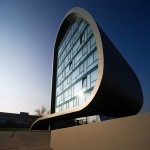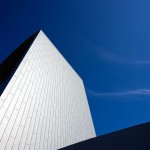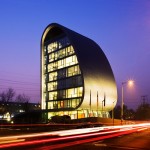Budapest, 2011
Senior designers: István Lukács Ybl Prize laureate architect, András Vikár DLA, Ybl Prize laureate architect
Contributing architects: Balázs Domokos, András Klopp
We won the opportunity to design the new headquarters of the Hungarian Automobile Club at a tender where the key aspect specified by the client was the simple yet emblematic appearance of the building.
The character of the building is dominated by a folded band curving up and falling back down, which can be interpreted as a folding road strip that embraces the transparent glass box containing the office spaces, but also as a reinterpretation of the letter “a” symbolizing the automobile club.
The building had a favourable reception by the district, as it is located near the end of the new Danube bridge and has the potential of becoming a distinctive landmark, a gate of Újpest over time.
The ground floor houses the client space, the upper floors contain offices, and the eighth floor houses a large rooftop terrace underneath the arching belt.
The approximately one metre thick band forming the upward curving arch has a varied width, while its ascension is laterally shifted. Accordingly, the vertical section – containing the elevator shaft and the stairwell – touches the ground at a different width and position than the horizontal strip it loops back into. The choice of material for the two dominant elements – the shell and the enclosed box – is also subordinated to the basic idea, so the shell is a contiguous metal-clad band with a seven floors high glass curtain wall lining the interiors.
Despite the unusual form, the construction costs were barely higher than those of a traditional building of similar parameters. The building was constructed conforming to the latest energy efficiency directives: its energy supply is served by a geothermal system. The low operating costs registered since the handover have fully confirmed our preliminary expectations.
A number of international architectural publications have featured the building.
Photography: Tamás Bujnovszky







